
NYC Montage (Source, http://en.wikipedia.org/wiki/File:NYC_Montage_2014_4_-_Jleon.jpg)
As of the busiest and widely known cities in the world, New York is generally what typifies our notions of what city life looks like. The city has always been a space that diverse immigrant groups, both domestic and foreign, have made home and where many movements and event important to our American identity and culture have first surfaced. While most think about the city as being merely the historical setting for urban phenomena and societal forces such as violence, poverty, protests and liberation; cities themselves are not exempt from this. As was first stated by Paul Knox, cities are not only the setting for the many phenomena that affect our lives but they themselves are nothing more than a physical reflection of these forces. New York is no different and has undergone dramatic changes as a result of capitalism and its shift from a national to a transnational, or global, phase.
1934 – National Housing Act is passed. This leads to the formation of the Federal Housing Administration, created with the goal of reviving the housing industry post Great Depression (Hevesi 2004).

Fiorello Laguardia (Source, http://upload.wikimedia.org/wikipedia/commons/b/b2/Fiorello_LaGuardia.jpg)
1934 – Newly Elected Mayor Fiorello La Guardia Appoints Robert Moses to be Commissioner of the Department of Parks and member of the Triborough Bridge Authority (Columbia University, 2014)
1946 – Robert Moses begins his campaign to renew New York through new bridges, freeways, and slum clearance (Columbia University, 2014).This era (1946-1960) saw the construction of the United Nations, the Cross Bronx Expressway, the Belt Parkway, and many of the city’s slum clearance projects (Sarachan 2014). These projects made it much more feasible for residents to commute into the city from the outer suburbs (Columbia University, 2014).

Verrazano-Narrows Bridge (Source, http://media.silive.com/advance/photo/2009/11/-d0ea3fc57173f719.JPG)
1950-1970 – National period of rapid suburban growth begins. This trend was supported by the demand for housing post World War II and the policy changes levied by the Federal Housing Administration concerning home lending (Hevesi 2004)
1951 – The first Levittown Community is finished. “Located on Long Island, the first Levittown community was completed in 1951 and contained more than 17,000 homes—making Levittown the nation’s largest housing development constructed by a single builder” (Hevesi 2004, 5). Through use of mass production and constrained options, the Levitt & Sons construction company ushered in a new era of affordable housing for middle class families away from the city (Hevesi 2004).

Levittown Postcard (Source, http://www.capitalcentury.com/levittown.jpg)
1961 – City begins to run annual financial deficits as public employees unions strike, middle class families steadily move to suburban developments, and increasing rent controls slow the growth of tax revenues (Dunstan 1995). City begins borrowing to pay for expanded city support services and employee contracts (Dunstan 1995). These services included the “city’s nineteen public hospitals, extensive mass transit and public housing, public daycare and decent schools, and its municipal university system—the only one of its kind in the country—provided higher education to all, free of charge” (Phillips-Fein 2013).
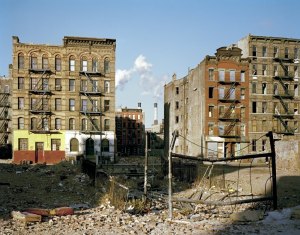
Lower East Side 1980 (Source, http://2.bp.blogspot.com/_p2jgVV2iZVs/TDtoitje9AI/AAAAAAAAfCo/F_OIKm2hWHE/s1600/-3.jpg)
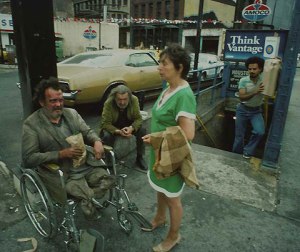
NYC Poverty (Source, http://dope.sg/wp-content/uploads/2012/01/Steven-Siegel-photo5.jpg)
1970 – Deterioration of city’s financial stability grows as the living conditions for poor New Yorkers worsens. “Between 1970 and 1980, the number of poor people in New York City increased by 20% even as the city’s population declined by 10%” (Freudenberg et. al. 2006). During this time, people were also displaced from their homes due to things such as landlord abandonment and arson (Freudenberg et. al. 2006). Deterioration of the urban environment encouraged continued suburban abandonment of the city both by families and corporate decision makers and further loss of tax revenues (Freudenberg et. al. 2006).
1971 – NASDAQ is established as the world’s first electronic stock exchange (Terrell 2012)
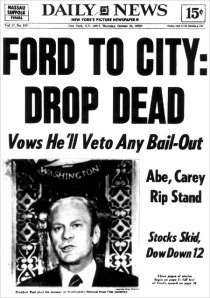
Newspaper Headline during Financial Crisis (Source, http://graphics8.nytimes.com/images/2006/12/28/nyregion/28veto_lg.jpg)
1975 – City financial crisis sends New York toward the brink of bankruptcy. After what many viewed to be years of borrowing to support the great society era social welfare programs of the city, banks bar the city for borrowing any more funding (Freudenberg et. al. 2006; Phillips-Fein 2013). Additionally, under President Ford, the city was told that no federal assistance would be provided for the city (Freudenberg et. al. 2006; Phillips-Fein 2013). In order to avoid bankruptcy, New York comes under control of an Emergency Financial Control Board (EFCB) responsible for balancing the city’s budget so that it could once again borrow money from public creditors (Freudenberg et. al. 2006). This is accomplished via cuts to all city services and reductions in city employment (Freudenberg et. al. 2006).
1976 – The city loses 468,000 manufacturing jobs between 1970-1976. Additionally, one in five public sector jobs had been lost by 1980, eliminating two of the traditional means of exiting poverty (Freudenberg et. al. 2006).

1980s NYC Subway (Source, http://flavorwire.files.wordpress.com/2013/10/subway1.png)
1981 – Cuts under the EFCB begin to take their toll on the city. The Wall Street Journal writes, “Basic city services, once the model for urban areas across the nation, have been slashed to the point of breakdown. Evidence of the cutbacks is everywhere: The streets are blanketed with garbage. Robberies, to name one crime, are at an all-time high. The subway system is near collapse, plagued by aging equipment, vandalism, and frequent breakdowns and derailments” (Freudenberg et. al. 2006).
1981 – “New York City was able to reenter the public credit market and all subsequent city budgets have met the legal requirement for a balanced budget” (Freudenberg et.al. 2006)
1987 – Producer services careers (such as finance, Insurance, and Real Estate) account for 37.5 percent of job growth. Manufacturing and Transport jobs continue to fall by 22 percent and 20 percent respectively (Sassen 2012)
1991 – The Internet first becomes available for public use (Bryant 2011)
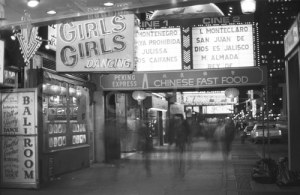
Times Square 1980s (Source: http://www.shootles.com/images/shootles//th/lan/nyc.p13r7n3-t.jpg)

Refurbished New Amsterdam Theater (Source, https://globalcitiesblog.wordpress.com/wp-admin/post.php?post=171&action=edit)
1994 – The Disney Corporation announces that it will purchase and rehabilitate Times Square’s New Amsterdam Theater (Martin 1994)
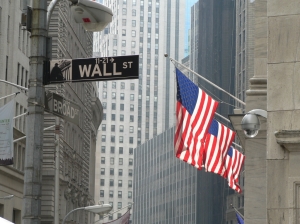
Wall Street (Source, http://glcbitcoin.com/wp-content/uploads/2014/01/wall-street.jpg?w=300)
1990-1999 – Wall Street accounts for 70 percent of the city’s output growth. This is in comparison to the 1980 when Wall Street only accounted for 18 percent (Fiscal Policy Institute 2002)
1997-1999 – The city experiences record levels of private sector job creation. However, this newfound prosperity is concentrated at the upper levels of the income spectrum (Fiscal Policy Institute 1999)
1990-2000 – City’s foreign-born population grows by 38 percent to 2.9 million (Dept. of City Planning 2014)

The High line (Source, http://graphics8.nytimes.com/images/2011/08/28/fashion/28HIGHLINE/28HIGHLINE-articleLarge.jpg)
2002-2013 – Michael Bloomberg is elected mayor of the city. During his term in office, he oversaw massive city rezoning and construction, the creation of new parks such as the high line, updating of building codes to protect the city from future storms like Hurricane Sandy, expanded bike lanes, and the introduction of the Citi-bike Bike Share system. He also oversaw an expansion of the city’s homeless population, expanded income inequality, and the implementation of the “Stop and Frisk” policing practice. (NY Times Editorial Board 2013)

A “Creative Class” Habitat (Source, http://assets.nydailynews.com/polopoly_fs/1.1561591!/img/httpImage/image.jpg_gen/derivatives/article_1200/bloomberg31f-1-web.jpg)
2008 – “U.S. exported legal services worth $7.3 billion; much of this is attributed to firms based in New York City” (Levin Institute 2011 2)
2005-2009 – “The international revenue of New York [architecture] firms grew 84 percent. As of 2009, 39 percent of revenue of New York City architecture firms was from overseas projects.” (Levin Institute 2011 2)
2011 – More than 800 fashion design and merchandising companies have their headquarters in New York; more than double the number in Paris” (Levin Institute 2011 3)

A Growing New York (Source, http://news.bbcimg.co.uk/media/images/68020000/jpg/_68020419_68016762.jpg)
2010-2013 – City continues trend net gains in resident migration for third consecutive year. This represents the city’s first solid population growth trend since the late 1940s/early 1950s. (Roberts 2014)
Sources
Hevesi, Alan G. 2004. Population Trends in New York State’s Cities. In Local Government Issues in Focus. Albany: Division of Local Government Services and Economic Development.
Levin Institute. 2011. New York in the World – Executive Summary. New York: State University of New York.
Fiscal Policy Institute. 2002. Learning from the 90s: How poor public choices contributed to income erosion in New York City, and what we can do to chart an effective course out of the current downturn. New York: Fiscal Policy Institute.
Dunstan, Roger. 1995. Overview of New York City’s Financial Crisis. Sacramento: California State Library.
Columbia University. 2014. “Robert Moses and the Modern City.” Columbia University. http://www.learn.columbia.edu/moses/.
Phillips-Fein, Kim. 2013. “The Legacy of the 1970s Fiscal Crisis.” The Nation.
Sarachan, Sydney. 2013. The Legacy of Robert Moses. PBS.
Freudenberg, Nicholas, Marianne Fahs, Sandro Galea, and Andrew Greenberg. 2006. “The Impact of New York City’s 1975 Fiscal Crisis on the Tuberculosis, HIV, and Homicide Syndemic.” American Journal of Public Health 96 (3):10.
Terrell, Ellen. 2012. “History of the American and NASDAQ Stock Exchanges – Selected References.” Library of Congress. http://www.loc.gov/rr/business/amex/amex.html.
Martin, Douglas. 1993. “Disney Seals Times Square Theater Deal.” New York Times, February 3, B. http://www.nytimes.com/1994/02/03/nyregion/disney-seals-times-square-theater-deal.html.
Board, Times Editorial. 2013. “12 Years of Mayor Bloomberg.” New York Times, 18, SR. http://www.nytimes.com/2013/12/29/opinion/sunday/12-years-of-mayor-bloomberg.html.
Planning, Department of City. 2014. The Newest New Yorkers – 2000 Edition – Executive Summary. In POPULATION. New York: City of New York.
Roberts, Sam. 2014. “Population Growth in New York City Is Reversing Decades-Old Trend, Estimates Show.” New York Times, 26, A. http://www.nytimes.com/2014/03/27/nyregion/population-growth-in-new-york-city-is-reversing-decades-old-trend-estimates-show.html.
Sassen, Saskia. 2012. Cities in a World Economy. United States: Sage.
